
If You See This Plant In Your Backyard, Don’t Step On It
"The lost herbs" by Nicole Apelian
Every gardener has had that moment when you come across a new plant that has sprung up from seemingly nowhere, and you’re not sure whether to pull out the suspected weed while it’s still at a manageable stage, or nurture it as a welcome addition to your backyard.
Chicory (Cichorium intybus) is one of these plants that many people assume is a weed, but in fact is one of the many herbs that are valued for its therapeutic and medicinal properties.
The bright blue flowers of chicory look fantastic in the garden, and it’s definitely a worthy herb to have on hand. It has numerous medicinal uses, it brings out the flavor of coffee, it makes a good livestock feed, it is used to make colorfast dyes and it’s a popular culinary herb.
How To Identify It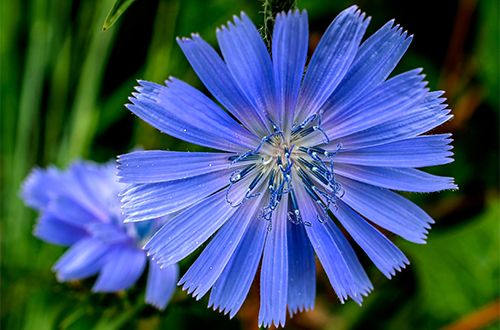
The bright blue flowers are the easiest way to identify chicory. The tips of the petals are toothed, which makes it look a little bit like a blue dandelion. It even has a similar number of petals – around 20. The flowers open early in the morning, and close again by lunchtime.
When it first emerges, the leaves form a flat rosette, just like a dandelion, however, it has a much taller, tougher stem (up to 3 feet), which is multibranched, hairy and holds a number of flowers, along with a few small leaves. It can also be distinguished by the white milky sap from the stems and leaves.
This perennial herb has a thin taproot, which allows it to re-shoot rapidly. You may stumble across this herb growing in your garden as a result of ants collecting and moving its seed around, but unlike dandelions, it doesn’t use wind as a means of seed dispersal.
Harvesting Instructions
Harvesting chicory is a matter of cutting the tall stems a few inches above the ground with a pair of pruning shears, and leaving the taproot to re-sprout and produce more flowers. You can usually get a second harvest from them, and in a good year, three. This is one reason why chicory is suitable for making fresh fodder for animals.
The root typically has a higher concentration of some of the medicinal compounds, and it is possible to dig up half the taproot, and the remaining half might still re-shoot and regenerate.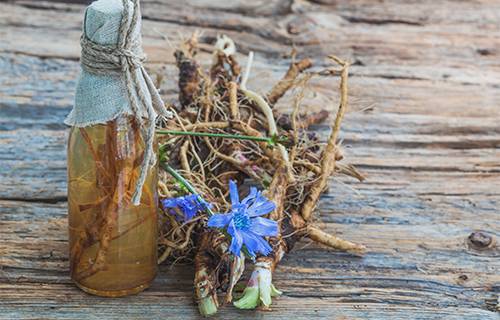
Historical Medicinal Uses
Chicory has been used medicinally across Europe since the Middle Ages. During the renaissance period, it was thought that the healing power of a plant was based on what it looked like. For example, because chicory has a milky, white sap, this apparently meant it could increase or decrease the amount of breast milk produced by mothers; its closed flowers meant it could treat infected eyes; bruises could be treated with its bruised leaves, and so on.
Suffice to say, that this method of assigning medicinal qualities based on observed physical traits was generally inaccurate (although quite amusing and interesting now). Some cultures claimed that it could make you invisible.
On the other hand, it was accurately touted as a ‘friend of the liver’ back in 200 A.D, and has been made into a popular liver tonic ever since then. People suffering from a toothache were made to chew on the bitter leaves or roots to alleviate the pain and swelling.
Modern Medicinal Uses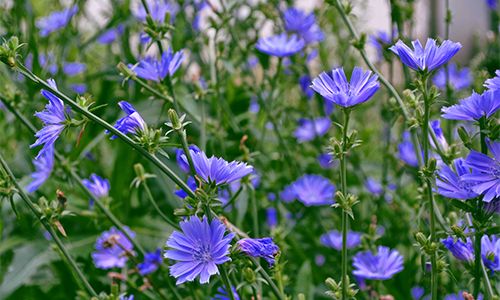
Luckily, modern studies have investigated the medicinal value of chicory. Just like many other plants, the bitter taste of chicory has been found to increase the amount of bile produced by the liver, and therefore, it can aid digestion, and possibly treat kidney stones, gallstones and various other liver ailments (so it really is a ‘friend of the liver’).
The white sap found throughout the whole plant contains lactucarium. This is a similar compound to opium, but much milder and safer. It’s lactucarium that gives chicory its mild sedative and anti-inflammatory properties, and which provides pain relief. It has been found to be as effective as other non-steroidal anti-inflammatory drugs, such as Ibuprofen pain killers.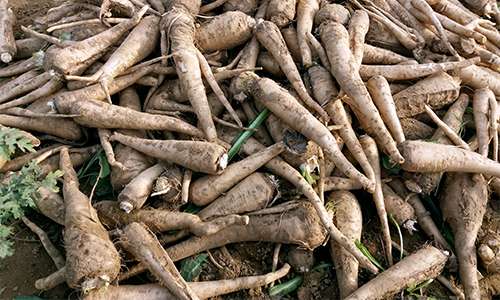 Studies have also found the roots to be high in anti-oxidants and have strong anti-bacterial properties. Chicory roots can also decrease blood pressure by expanding blood vessel walls. As a diuretic, it stimulates the production of urine, which therefore assists the kidneys to remove toxins and excess fluids. This increase in urination leads to the removal of uric acid and excess fluids, which can subsequently treat arthritis, gout and urinary tract infections.
Studies have also found the roots to be high in anti-oxidants and have strong anti-bacterial properties. Chicory roots can also decrease blood pressure by expanding blood vessel walls. As a diuretic, it stimulates the production of urine, which therefore assists the kidneys to remove toxins and excess fluids. This increase in urination leads to the removal of uric acid and excess fluids, which can subsequently treat arthritis, gout and urinary tract infections.
Chicory can reduce the severity of allergic reactions by inhibiting the production of histamines.
Although quite small, chicory root is a surprising source of fiber. It consists of 16% inulin, which is a soluble type of fiber that is associated with improving the health of the entire intestinal track, as well as responsible for producing a mild laxative and sedative effect. It is surprisingly common in gluten-free and high fiber products, and when processed, inulin takes on a slightly sweet taste which can also be used as a natural sweetener.
Research has also identified some compounds in chicory that can kill the malaria parasite and mosquito larvae.
How To Use Chicory As Medicine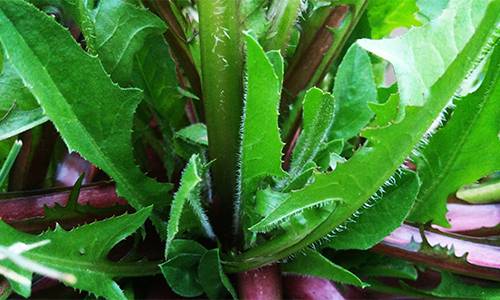
The easiest way to use chicory is to ingest it. The leaves add flavor to a salad, and both the leaves and roots make a nice addition to pickling recipes, and go well in a roast, although some of the compounds and nutrients degrade when cooked.
A poultice can be made quickly by crushing or grinding a fresh plant and binding it to any sore joints or muscles. Or you can prepare a tincture or salve to have on hand in the medicine draw at home to massage into tired, aching muscles.
Having some dried chicory tucked away in a cupboard means you can brew some chicory tea anytime. The tea should be brewed for at least 5 minutes. Otherwise you can grind up roasted roots to either add to your coffee, or to substitute your coffee for a caffeine-free drink.
Something You Must Know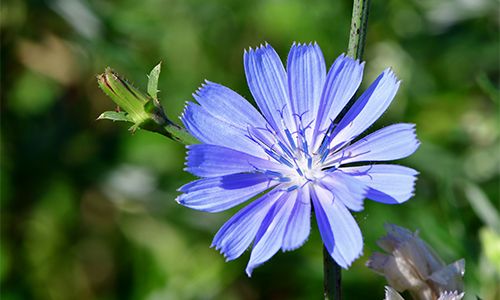
Studies have shown chicory to be reasonably effective at decreasing blood sugar levels, so people with diabetes need to be cautious when ingesting this herb.
Since this is yet another plant from the daisy family (Asteraceae), then anyone who is allergic to ragwort, daisies or marigolds should avoid growing, handling or consuming chicory.
Chicory can stimulate the uterus and cause miscarriage, so shouldn’t be eaten when pregnant.
The white sap of chicory can cause an irritation in people with very sensitive skin, but most people don’t have any issues handling it.
So, if you see chicory sprouting in your backyard, don’t be too hasty to rip it out and throw it in the compost pile with the rest of the weeds. It could turn out to be your next medicine, meal, drink, animal feed or dye.
Please subscribe to our YouTube channel here, Thanks!


Leave a comment